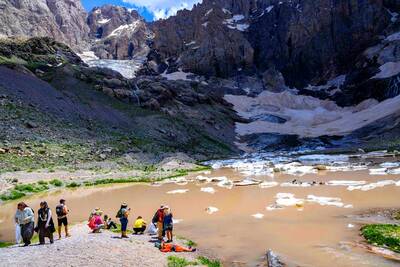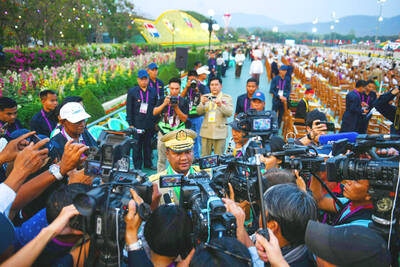A tiny southern emu wren, which conservationists fear is under threat from rocket launches in Australia, could be listed as endangered within days.
Planned rocket launches on the Eyre Peninsula in South Australia state pose an extinction-level threat to the wren, one of Australia’s smallest birds, conservationists said.
The subspecies of southern emu wren at the site is listed as endangered under state law, but as vulnerable nationally.

Photo: AP
Australian Minister for the Environment and Water Tanya Plibersek is considering lifting the national status to endangered, which would affect project approvals and funding decisions.
Southern Launch’s rocket facility is on the tip of the Eyre Peninsula at Whalers Way, which is “habitat critical to the survival of the species.”
Southern Launch said that its feral animal eradication programs would have a positive effect on the bird’s habitat.
Meanwhile Plibersek is considering the overall approval of the rocket launch site under the Australian Environment Protection and Biodiversity Conservation Act.
The state government would also need to approve it.
The Nature Conservation Society of South Australia said that land clearance, disturbance by humans including noise, vibrations and traffic, as well as an increased risk of bushfires, put the bird at extreme risk.
The society’s Julia Peacock said it was an environmentally sensitive spot for a range of reasons, particularly the wren.
“It’s a beautiful little bird, difficult to see, it makes a beautiful trilling, like a tinkling of glass,” Peacock said. “There are so few of these left. At best 1,000 across previously known sites. It could be as few as 500. The Whalers Way estimate [which is rubbery] is possibly 100 pairs, 200 birds.”
“We’re talking about a subspecies that’s really threatened,” she said. “What it needs is its habitat to be protected.”
Populations of the wren, which have bodies about 6cm long, had previously been lost in bushfires, Peacock said, adding that the site was already high-risk for bushfires even without the launches.
Southern Launch has tested suborbital rocket launches at its inland Koonibba Test Range. The company has a second site at the Whalers Way Orbital Launch Complex, a spaceport on private land that plans to put craft into orbit carrying customers’ satellites.
It has applied for a permanent facility there.
Southern Launch chief executive officer Lloyd Damp said the company had engaged “pre-eminent independent experts” as part of its environmental impact statement and Environment Protection and Biodiversity Conservation Act documentation development.
“The outcomes show we will have a very positive effect on their habitat through environmental management such as feral animal eradication programs,” Damp said.
South Australia Legislative Council member Tammy Franks of the Greens Party is pushing for an inquiry into the initial approval of the launch site.
While she supported the establishment of a space industry, the Whalers Way site contains a unique ecosystem and an alternative site should be found, Franks said.
She was concerned about impacts on the surrounding marine park, as well as on endangered species.
The white-bellied sea eagle, eastern osprey and white-bellied whipbird were also at risk, she said.
“While the development of a space industry is welcome, it shouldn’t come at the cost of our environment when there are so many other options not yet considered,” Franks said. “The process has been vague and community questions remain unanswered. It’s clear that we need a comprehensive inquiry into the whole project.”
Damp said that Whalers Way was the right place “for both environmental and commercial reasons.”
Southern Launch’s bushfire plan had been approved by the Country Fire Service and the company would work alongside regulators, he said.
Southern Launch planned to use rockets from 10m to 30m tall to carry small satellites into orbit, eventually launching up to 36 a year along with another six suborbital launches.
It chose the 1,200 hectare site for reasons including its remoteness and the ability to launch rockets over the Great Australian Bight instead of populated land.
A spokesperson for the Australian Department of Agriculture, Water and the Environment said the listing for the southern emu wren was still being finalized.
Being “uplisted” from vulnerable to endangered nationally would signal that the wren was closer to extinction.
“Threatened species listed under national environment law are protected as matters of national environmental significance,” the spokesperson said. “Any action requires government approval if the action has, will have, or is likely to have a significant impact on a listed threatened species. The action must be referred to the minister for the environment and undergo an environmental assessment and approval process.”

In the sweltering streets of Jakarta, buskers carry towering, hollow puppets and pass around a bucket for donations. Now, they fear becoming outlaws. City authorities said they would crack down on use of the sacred ondel-ondel puppets, which can stand as tall as a truck, and they are drafting legislation to remove what they view as a street nuisance. Performances featuring the puppets — originally used by Jakarta’s Betawi people to ward off evil spirits — would be allowed only at set events. The ban could leave many ondel-ondel buskers in Jakarta jobless. “I am confused and anxious. I fear getting raided or even

Kemal Ozdemir looked up at the bare peaks of Mount Cilo in Turkey’s Kurdish majority southeast. “There were glaciers 10 years ago,” he recalled under a cloudless sky. A mountain guide for 15 years, Ozdemir then turned toward the torrent carrying dozens of blocks of ice below a slope covered with grass and rocks — a sign of glacier loss being exacerbated by global warming. “You can see that there are quite a few pieces of glacier in the water right now ... the reason why the waterfalls flow lushly actually shows us how fast the ice is melting,” he said.

RISING RACISM: A Japanese group called on China to assure safety in the country, while the Chinese embassy in Tokyo urged action against a ‘surge in xenophobia’ A Japanese woman living in China was attacked and injured by a man in a subway station in Suzhou, China, Japanese media said, hours after two Chinese men were seriously injured in violence in Tokyo. The attacks on Thursday raised concern about xenophobic sentiment in China and Japan that have been blamed for assaults in both countries. It was the third attack involving Japanese living in China since last year. In the two previous cases in China, Chinese authorities have insisted they were isolated incidents. Japanese broadcaster NHK did not identify the woman injured in Suzhou by name, but, citing the Japanese

RESTRUCTURE: Myanmar’s military has ended emergency rule and announced plans for elections in December, but critics said the move aims to entrench junta control Myanmar’s military government announced on Thursday that it was ending the state of emergency declared after it seized power in 2021 and would restructure administrative bodies to prepare for the new election at the end of the year. However, the polls planned for an unspecified date in December face serious obstacles, including a civil war raging over most of the country and pledges by opponents of the military rule to derail the election because they believe it can be neither free nor fair. Under the restructuring, Myanmar’s junta chief Min Aung Hlaing is giving up two posts, but would stay at the